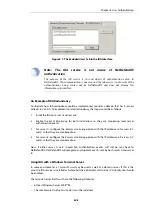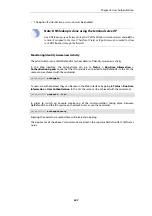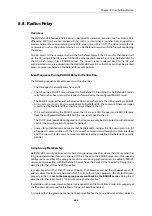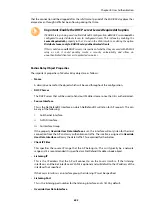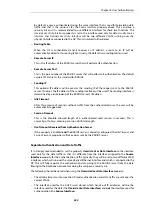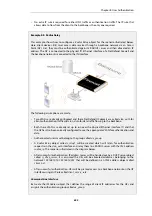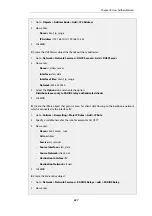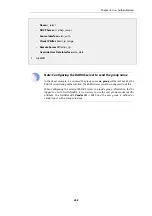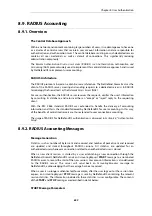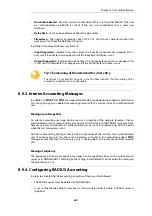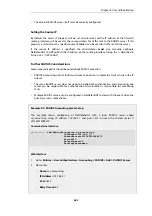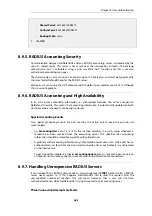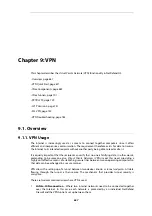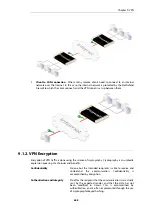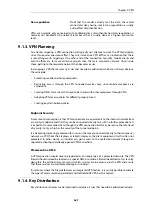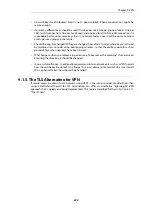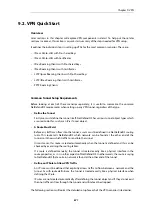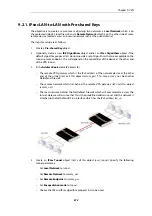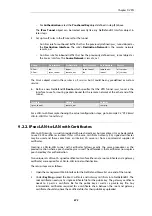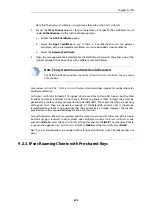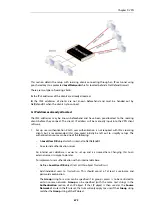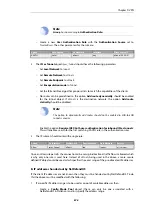
•
How Authenticated - How the user was authenticated. This is set to either
RADIUS
if the user
was authenticated via RADIUS, or
LOCAL
if the user was authenticated via a local user
database.
•
Delay Time - See the above comment about this parameter.
•
Timestamp - The number of seconds since 1970-01-01. Used to set a timestamp when this
packet was sent from the NetDefend Firewall.
In addition, two more attributes may be sent:
•
Input Gigawords - Indicates how many times the Input Bytes counter has wrapped. This is
only sent if Input Bytes has wrapped, and if the Input Bytes attribute is sent.
•
Output Gigawords - Indicates how many times the Output Bytes counter has wrapped. This
is only sent if Output Bytes has wrapped, and if the Output Bytes attribute is sent.
Tip: The meaning of the asterisk after a list entry
The asterisk (*) symbol after an entry in the list above indicates that the sending of the
parameter is optional and is configurable.
8.9.3. Interim Accounting Messages
In addition to START and STOP messages NetDefendOS can optionally periodically send
Interim
Accounting Messages
to update the accounting server with the current status of an authenticated
user.
Messages are Snapshots
An interim accounting message can be seen as a snapshot of the network resources that an
authenticated user has used up until a given point. With this feature, the RADIUS server can track
how many bytes and packets an authenticated user has sent and received up until the point
when the last message was sent.
An Interim Accounting Message contains the current values of the statistics for an authenticated
user. It contains more or less the same parameters as found in an accounting request STOP
message, except that the
Acct-Terminate-Cause
is not included (as the user has not disconnected
yet).
Message Frequency
The frequency of interim accounting messages can be specified either on the authentication
server or in NetDefendOS. Switching on the setting in NetDefendOS will override the setting on
the accounting server.
8.9.4. Configuring RADIUS Accounting
In order to activate RADIUS accounting a number of steps must be followed:
•
The RADIUS server must be defined in NetDefendOS.
•
A user authentication object must have a rule associated with it where a RADIUS server is
specified.
Chapter 8: User Authentication
661
Summary of Contents for NetDefendOS
Page 30: ...Figure 1 3 Packet Flow Schematic Part III Chapter 1 NetDefendOS Overview 30 ...
Page 32: ...Chapter 1 NetDefendOS Overview 32 ...
Page 144: ...Chapter 2 Management and Maintenance 144 ...
Page 284: ...Chapter 3 Fundamentals 284 ...
Page 392: ...Chapter 4 Routing 392 ...
Page 419: ... Host 2001 DB8 1 MAC 00 90 12 13 14 15 5 Click OK Chapter 5 DHCP Services 419 ...
Page 420: ...Chapter 5 DHCP Services 420 ...
Page 573: ...Chapter 6 Security Mechanisms 573 ...
Page 607: ...Chapter 7 Address Translation 607 ...
Page 666: ...Chapter 8 User Authentication 666 ...
Page 775: ...Chapter 9 VPN 775 ...
Page 819: ...Chapter 10 Traffic Management 819 ...
Page 842: ...Chapter 11 High Availability 842 ...
Page 866: ...Default Enabled Chapter 13 Advanced Settings 866 ...
Page 879: ...Chapter 13 Advanced Settings 879 ...


